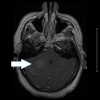Adult Medulloblastoma: Occurrence of a Rare Event
- PMID: 30397563
- PMCID: PMC6207282
- DOI: 10.7759/cureus.3000
Adult Medulloblastoma: Occurrence of a Rare Event
Abstract
Medulloblastoma is the most common type of aggressive pediatric primary brain malignancy. This case describes a 45-year-old Hispanic male with no significant past medical history who presented to the emergency department (ED) complaining of 15 days of 10/10 intractable headaches with one day of lightheadedness, confusion, and loss of balance. An urgent magnetic resonance imaging (MRI) of the brain revealed a 4.1 x 3.3 x 3.2 cm mass at the cerebellum, exerting a mass effect on the brainstem and mild tonsillar herniation. A pre-surgical physical exam revealed only a positive Babinski sign bilaterally with normal proprioception and cerebellar function. The intraoperative report concluded an undifferentiated neoplasm with a histological differential diagnosis of medulloblastoma, ependymoma, or other neuroepithelial neoplasms, suggesting a referral to a tertiary care center for further evaluation of the mass. Postsurgical complications included a severe vasogenic edema, causing obstructive hydrocephalus treated with frontal ventricular drainage, signs of meningitis treated with antibiotics, and hyponatremia. This case describes a rare occurrence of medulloblastoma in an adult patient, which required prompt diagnosis and urgent life-saving treatment.
Keywords: adult; medulloblastoma.
Conflict of interest statement
The authors have declared that no competing interests exist.
Figures


References
-
- Epidemiology of brain tumors in childhood—a review. Baldwin RT, Preston-Martin S. Toxicol Appl Pharmacol. 2004;199:118–131. - PubMed
-
- The incidence of medulloblastomas and primitive neurectodermal tumours in adults and children. Smoll NR, Drummond KJ. J Clin Neurosci. 2012;19:1541–1544. - PubMed
-
- Epidemiology of adult medulloblastoma. Giordana MT, Schiffer P, Lanotte M, Girardi P, Chio A. Int J Cancer. 1999;80:689–692. - PubMed
-
- Survival of patients with adult medulloblastoma: a population-based study. Lai R. Cancer. 2008;112:1568–1574. - PubMed
-
- Common strategy for adult and pediatric medulloblastoma: a multicenter series of 253 adults. [Jul;2018 ];Padovani L, Sunyach M, Perol D, Mercier C, Alapetite C, Haie-Meder C. Int J Radiat Oncol Biol Phys. 2007 68:433–440. - PubMed
Publication types
LinkOut - more resources
Full Text Sources
Miscellaneous
